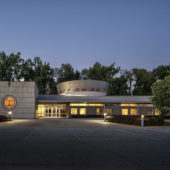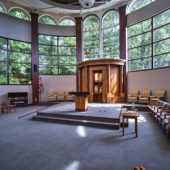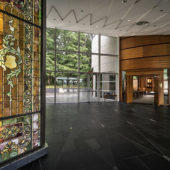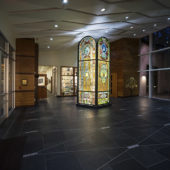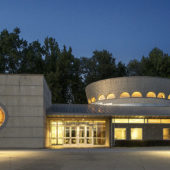A spectacular, iconic synagogue befitting a Jewish community dating from 1857.
The following material is quoted from a booklet prepared for the celebration of the sesquicentennial of the Jewish community in Evansville : “The history of the Jewish community in Evansville began in 1837 with the arrival of the Gumberts family followed a year later by Isaac Heimann. By 1850, most Indiana towns had three or four Jewish families. According to the Jewish Encyclopedia, early Hoosiers were German Jews who traveled across the Atlantic, arriving on the East Coast, crossing the Appalachian Mountains by pack-wagon or stage coach and finally floating down river from Pittsburgh by flat-boat. What made Evansville appealing was the large number of German speaking people among the 1800 residents as well as the fact that Evansville had been designated as the terminus for the largest canal project in the world. In addition, a branch of the new state bank was coming to Evansville, making business transactions easier.
By 1850, there were enough Jews in Evansville for a minyan. Services were held in homes or buildings, such as the second floor of Keller’s Gun Store. Most of the people were secular or non-practicing in their Judaism but they still wanted a religious presence in their new home. The first synagogue in Indiana was established in Fort Wayne in 1848, Indianapolis followed in 1856 and then Evansville in 1857. In neighboring Kentucky, Owensboro, Paducah and Henderson established synagogues in the late 1850s to 1880s. From the outset, congregations were liberal with mixed seating and preaching was in English and German and very little Hebrew. .
On August 13, 1857, the Jewish community organized as B’nai Israel with the first trustees being Jacob Loewenthal, Louis Kahn, Simon Gumberts, Louis Frey and Simon Roser. David Heimann was the first president. The Evansville Daily Journal of September 21, 1857 reported extensively on the congregation&%39;s first worship services, held the previous Saturday and Sunday. Approximately forty male adults who form an enterprising, industrious, and wealthy class participated in the first service, said the newspaper report.” .
The 2003 building was designed by Michael Landau, architect, of Princeton, New Jersey. Landau says “The program for this congregation is unique in that large overflow Holiday crowds are not a factor. This use pattern allows the sanctuary and social hall to function separately at all time and affords an opportunity to express these primary spaces as discrete elements within the overall composition. The resulting design is a simple but powerful collection of pure forms grounded in a tilting plane. The cylinder of the sanctuary is capped by an abstracted crown symbolizing the majesty of G-d [and also hides the mechanical equipment], the cube of the library-chapel, and the rectangular prism of the social hall, all intersect with a simple wedge-shaped bar of the base building.
The dominant design feature of the Sanctuary is a stepped pattern of twelve pairs of windows, which progress around the drum from a low point at the entry doors, to a high point behind the Bimah. Each pair of windows is aligned under a matching pair of half-round clerestory windows above. Only at the Bimah do these vertically aligned windows actually unite to form a pair of tablets etched with the Ten Commandments, revealing the unambiguously Jewish character of the space.
The building is an essay in balancing the particular with the universal. The use of local brick, Indiana limestone, and a standing seam roof tie the building to its specific locale in time and space, while the pure geometric forms give the structure a timeless quality. The sanctuary, in particular, expresses the purity of the axis mundi tempered by an asymmetrical exposed king post structural system which locates the center of the room over the Bimah rather than the geometric center of the circle, and supports an heirloom Ner Tamid (eternal light) which has traveled with the congregation, along with its stained glass windows, as it has moved from one home to another, growing and changing over the years yet still connecting with its history, a significant Jewish theme.”

